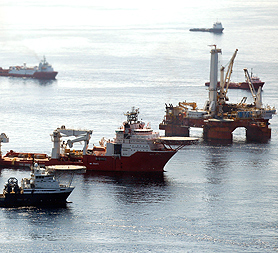Obama: BP oil spill 'coming to an end'
Updated on 04 August 2010
In an "important turning point", US experts say most of the oil spill in the Gulf of Mexico has dispersed, as Barack Obama says the battle to stop the leak is "close to coming to an end". Channel 4 News looks at where the oil has gone.

President Obama said the battle to stem the oil spill was finally drawing to a close.
"The long battle to stop the leak and contain the oil is finally close to coming to an end," Obama said at the start of a speech to the AFL-CIO union federation in Washington.
Earlier his energy adviser said that efforts to contain, burn and skim oily liquid from the Gulf have cleared up three quarters of the spill, with the remainder now not posing a serious threat.
"The good news is that the vast majority of the oil appears to be gone," Carol Browner said on ABC's Good Morning America. "That's what the initial assessment of our scientists is telling us."
"We do feel like this is an important turning point," she added. US experts said 74 per cent of the oil had dispersed, leaving 26 per cent that has yet to be captured - remaining as sheen or tarballs, buried in sediment or washed ashore.
The oil group said today it has reached a significant milestone after pumping heavy mud into the well, pushing the oil back down to create a "static" condition.
Where has all the oil gone?
US scientists said today that 25 per cent of the oil has naturally evaporated in the heat.
A further 24 per cent has been dispersed into small droplets - either naturally broken down by a resilient ocean, eaten by oil-munching bacteria, or "as a result of operations".
Unified Command, which includes government and private efforts, has burnt, skimmed or scooped up another 25 percent - bringing the total now removed from the ocean to 74 per cent of the estimated 4.9m barrels spilled.
"There is evaporation and then there is natural weathering of the oil. And this varies with the type of oil and where you are at in the world. We happen to be in an area where there are high temperatures and optimal conditions environmentally," Admiral Thad Allen has said previously.
The Gulf - an area of naturally occurring oil seeps – is rich in oil-eating microbes that, given sufficient oxygen, can break down oil very quickly into carbon dioxide and water.
But oil measurements only take into account surface oil. BP used 800,000 gallons of dispersant on oil leaving the well a mile beneath the sea. Some claim the sub-sea dispersants have eliminated much of the oil, while others argue that much of the oil is not visible to the human eye, leaving wildlife vulnerable.
"The well pressure is now being controlled by the hydrostatic pressure of the drilling mud which is the desired outcome of the static kill procedure," BP said in a statement.
The well will then be plugged from the top with cement if the static kill procedure is successful – it is expected to last two or three days.
The group will still need to complete a relief well, National Incident Commander Admiral Thad Allen said, which BP expects to complete by mid-August.
Meanwhile, US officials estimated yesterday that the Macondo well spewed 4.9m barrels of oil into the Gulf before being capped last month.
BP has captured less than a fifth of this - skimming a total of 827,046 barrels of oily liquid from the Gulf and burning 265,238 barrels of oil from the water's surface.
Commander Allen said over the next couple of days scientists will be able to estimate how much oil remains in the Gulf.
"There's still residual oil out there," he said. "Our intention is to size our force based on the requirements - how much oil is out there and how much do we have to recover."
The New York Times said ahead of a government report today that three-quarters of the oil leak has evaporated, dispersed or been recovered.
Around just 26 per cent of the spilled oil remains in the Gulf, the government report is expected to say, of which most is a "light sheen" on the ocean surface, the newspaper said.
The oil giant has spent more than $4bn on the clean-up to date, including $277m paid out to victims of the spill.
It has also set aside a $20bn escrow fund, $100m unemployed rig workers’ fund and put $500m into establishing the Gulf Coast Research Institute.
However under the US Clean Water Act, if BP is found liable for gross negligence it could face fines of more than $20bn, according to latest estimates of the size of the spill.
Latest estimates from US government scientists found that 4.9m barrels of oil have poured into the sea since the Deepwater Horizon explosion on April 20.
The company could be fined between $1,100 and $4,300 per barrel of oil leaked – and so could be hit with a bill of up to $21bn.
BP said last week that it has made a $32.2bn provision in its second quarter results to cover clean-up costs and victims' compensation. It did admit that this may not be enough.
BP reported a record quarterly loss of $17.2bn, after $32.2bn of pretax charges related to the oil spill. BP also revealed plans to sell around $30bn worth of assets, and announced the exit of chief executive Tony Hayward.




